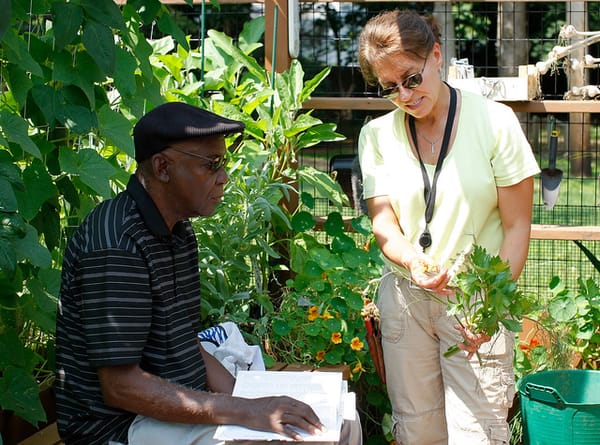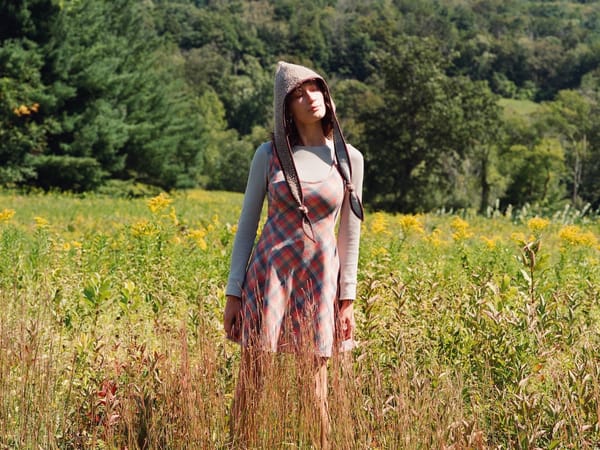Let's Get Dirty: Digging Into Some Horticultural Therapy
A class at the Berkshire Botanical Garden will focus on why working with plants is therapeutic.

A class at the Berkshire Botanical Garden will focus on why working with plants is therapeutic.

Anne Meore works with an elder client.
“Gardening is my therapy.”
Who hasn’t heard someone express that sentiment lately? Especially now, working in the garden is something we can do safely, for ourselves and for others. And while digging in the dirt might benefit our emotional health, it has many other benefits as well — so many that an academic discipline has sprouted up around the cultivation of plants. It’s called horticultural therapy, and the Berkshire Botanical Garden in Stockbridge, Mass. is providing an experiential course on it for those who are curious about how and why plants affect our health. “Horticultural Therapy: The People-Plant Partnership” will be offered September 19 from 10 a.m. to 2:30 p.m.
“The course will be a ‘hands-in’ exposure to the field of horticultural therapy,” says the instructor, Anne Meore, LMSW, HTR. The initials indicate that she is a social worker and a registered horticultural therapist with the American Horticultural Therapy Association. She is also a faculty member in the School of Horticulture at the New York Botanical Garden. “The class will hone in on the foundational aspects of the modality. Along with the hands-on activity, we’ll discuss our feeling associated with them.”
Like many horticultural therapists, Meore works in a hospital setting; she heads up the horticultural and garden therapy program at Good Samaritan Hospital in Suffern, New York. Normally, she says, she would be treating groups with special needs — whether cognitive, physical or those in the in-patient addictions unit — working together in the soil.
“Everything we grow there is edible and donated to a food pantry,” she says. “Most of these folks with special needs are recipients of care. Having the opportunity to grow things shifts the playing field. They’re empowered to be part of the solution to help someone else. It creates a beautiful cycle. The psycho-emotional benefit is endless.”
While the pandemic has forced the hospital to be closed to community members, Meore has seen plant therapy work on others on the campus. Deemed an essential employee, she’s been working in the hospital garden, situated beside the parking lot, since March. It was the staff members, bleary eyed coming in and out of the hospital, who received the benefit of the garden.
“The garden became this place where staff members got a restorative benefit, even if they didn’t know they needed it,” Meore says.
But why, exactly, does plant, nature, forest therapy feel so healing? And why have people felt so compelled to grow their victory gardens this past summer?
It’s a control issue, Meore says.
“Those of us who were able to go outside, or open a window and look at nature, have a tiny bit of an advantage of quelling that feeling of being out control. At the beginning of the shut-down, if you had a garden, the peas were coming. The leaves were unfurling, the soil was getting warmer — all things that normally happen at that time of year. Those things really helped many people get through this feeling of losing control.”
Meore, whose company Planthropy offers wellness counselling and therapeutic garden design, says that the Berkshire Botanical Garden class is for anyone who has an interest in the benefits of our relationship with plants and the natural environment. The Garden’s grounds will surely set the scene for some therapeutic adjustments and offer moments to practice mindfulness in nature.
In June, Meore taught a similar class for the BBG, although it was online. But even without the garden in real life, there could be much to learn. One participant, Vee Carrington, found the class interesting, informative, and validating.
“It kind of reinforced the ideas that had been poking around my head,” Carrington says. “Going to parks has always been soothing to me. The class encouraged me to keep along the path I was seeing in my own recovery from severe injuries and the loss of my husband. That horticultural therapy was a valid path to be taking, that sitting under a tree is a good way to relieve grief and stress. That there is a lot to be gained from working with plants.”








